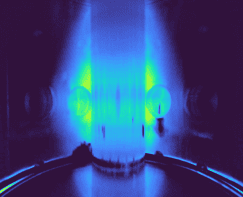
Research done at a mountaintop cosmic-ray observatory in Armenia has shed new light on how thunderstorms can create flashes of gamma rays by accelerating electrons. Further study of the phenomenon could answer important questions about the origins of lightning.
This accelerating process is called thunderstorm ground enhancement (TGE), whereby thunderstorms create strong electric fields that accelerate atmospheric free electrons to high energies. These electrons then collide with air molecules, creating a cascade of secondary charged particles. When charged particles are deflected in these collisions they emit gamma rays in a process called bremsstrahlung.
The flashes of gamma rays are called “gamma-ray glows” and are some of the strongest natural sources of high-energy radiation on Earth.
Physicist Joseph Dwyer at the University of New Hampshire, who was not involved in the Armenian study says, “When you think of gamma rays, you usually think of black holes or solar flares. You don’t think of inside the Earth’s troposphere as being a source of gamma rays, and we’re still trying to understand this.”
Century-old mystery
Indeed, the effect was first predicted a century ago by Nobel laureate Charles Wilson, who is best known for his invention of the cloud chamber radiation detector. However, despite numerous attempts over the decades, early researchers were unable to detect this acceleration.
This latest research was led by Ashot Chiliangrian, who is director of the Cosmic Ray Division of Armenia’s Yerevan Physics Institute. The measurements were made at a research station located 3200 m above sea level on Armenia’s Mount Aragats.
Chiliangrian says, “There were some people that were convinced that there was no such effect. But now, on Aragats, we can measure electrons and gamma rays directly from thunderclouds.”
In the summer of 2023, Chiliangrian and colleagues detected gamma rays, electrons, neutrons and other particles from intense TGE events. By analysing 56 of those events, the team has now concluded that the electric fields involved were close to Earth’s surface.
Though Aragats is not the first facility to confirm the existence of these gamma-ray glows, it is uniquely well-situated, sitting at a high altitude in an active storm region. This allows measurements to be made very close to thunderclouds.
Energy spectra
Instead of measuring the electric field directly, the team inferred its strength by analysing the energy spectra of electrons and gamma rays detected during TGE events.
By comparing the detected radiation to well-understood simulations of electron acceleration, the team deduced the strength of the electric field responsible for the particle showers as 2.1 kV/cm.
This field strength is substantially higher than what has been observed in most previous studies of thunderstorms, which typically use weather balloons to take direct field measurements.
The fact that such a high field can exist near the ground during a thunderstorm challenges previous assumptions about the limits of electric fields in the atmosphere.

Elves and gamma rays emerge simultaneously from thunderstorm
Moreover, this discovery could help solve one of the biggest mysteries in atmospheric science: how lightning is initiated. Despite decades of research, scientists have been unable to measure electric fields strong enough to break down the air and create the initial spark of lightning.
“These are nice measurements and they’re one piece of the puzzle,” says Dwyer, “What these are telling us is that these gamma ray glows are so powerful and they’re producing so much ionizing radiation that they’re partially discharging the thunderstorm.”
“As the thunderstorms try to charge up, these gamma rays turn on and cause the field to kind of collapse,” Dwyer explains, comparing it to stepping on bump in a carpet. “You collapse it in one place but it pops up in another, so this enhancement may be enough to help the lightning get started.”
The research is described in Physics Review D.


